The Art of Sustainable Development: Monitoring Riparian Zones in the Amazon
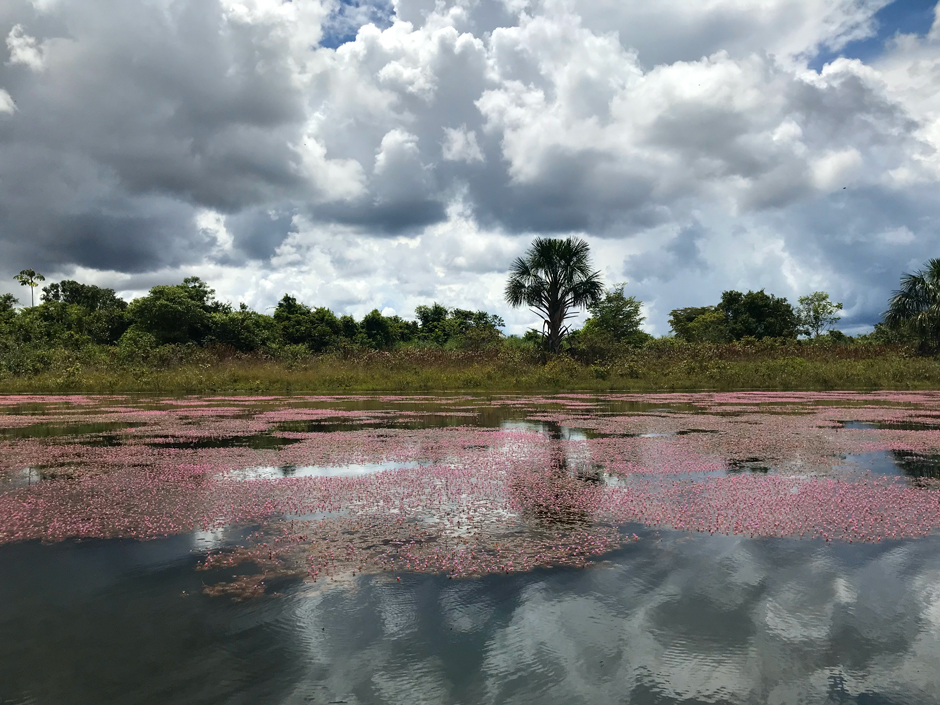 Aquatic vegetation blooming on the surface of a reservoir in Brazil. (Credit: Marcia Macedo)
Aquatic vegetation blooming on the surface of a reservoir in Brazil. (Credit: Marcia Macedo)As concerns for the planet’s future rise to the front pages of newspapers across the globe, so has the demand for science-based solutions to preserve and protect the earth and its resources. Sustainable development focuses on balancing the necessary harms of land use for global needs with environmental conservation. Marcia Macedo, an ecosystem ecologist and Director of the Water Program at the Woodwell Climate Research Center, understands how complicated sustainability can be.
While it is clear that the world is consuming resources at an unsustainable rate, understanding the full scope of the problem and developing solutions is challenging, particularly in a globalized world. Macedo has spent her career at the land-water interface studying how deforestation and land use change impact water flows in the tropics. She has spent over 15 years working with farmers in the Amazon and Cerrado biomes to help develop management strategies that allow continued crop production while minimizing harm to local watersheds. “We are trying to understand the main drivers of land use change in tropical regions, as well as the impacts of those changes on tropical watersheds,” says Macedo.
Drivers and Impacts of Land Use
The expansion of export-oriented crops and cattle ranching have been the two leading causes of deforestation in the Amazon-Cerrado region. These resulting land use changes have profoundly impacted the ecological functions of native forests and savannas, as well as the freshwater ecosystems draining those landscapes. The southeastern Amazon, where Macedo has worked since 2007, has experienced particularly rapid changes over the last two decades.
“There’s a tight relationship between forests and the hydrological cycle,” notes Macedo. Understanding those interactions and how strains on either system can affect the other is one of the fundamental goals of Woodwell’s work in the Amazon. Macedo and her colleagues – including atmospheric scientist and Director of the Tropics Program, Michael Coe – have spent years studying these connections from local to global scales.
Their results underscore the close connection between the fate of native forests and the hydrological cycle. Tropical trees are massive, with deep roots that return about three-quarters of rainfall back to the atmosphere through evapotranspiration. The resulting water vapor helps form rain clouds, providing essential rainfall downwind and helping to cool the land surface. “Tropical forests essentially act like big air conditioners for the ecosystem and surrounding areas,” explains Macedo.
It is no surprise, then, that removing those forests changes everything. Macedo elaborates, “It greatly reduces evapotranspiration, which not only reduces the amount of water recycled back to the atmosphere but also warms the land surface and increases stream discharge.” These local impacts on the hydrology of small watersheds are often compounded by other disturbances, many of which have unintended consequences and large cumulative effects at the landscape scale.
One such unsustainable practice is the construction of small earthen dams in sensitive headwater streams. These reservoirs – reminiscent of the small lakes formed by beaver dams or the mill dams commonly found in the northeastern US a century ago – can provide drinking water for cattle, irrigation, fish farming, or other recreational purposes. Although small, these impoundments stay in the landscape for decades and have proliferated throughout the Amazon-Cerrado agricultural region. Macedo and colleagues mapped thousands of these reservoirs in the headwaters of the Xingu River Basin in Mato Grosso, Brazil. A single farm where Macedo works contained over 50 of these reservoirs in an area roughly the size of Cape Cod, Massachusetts.
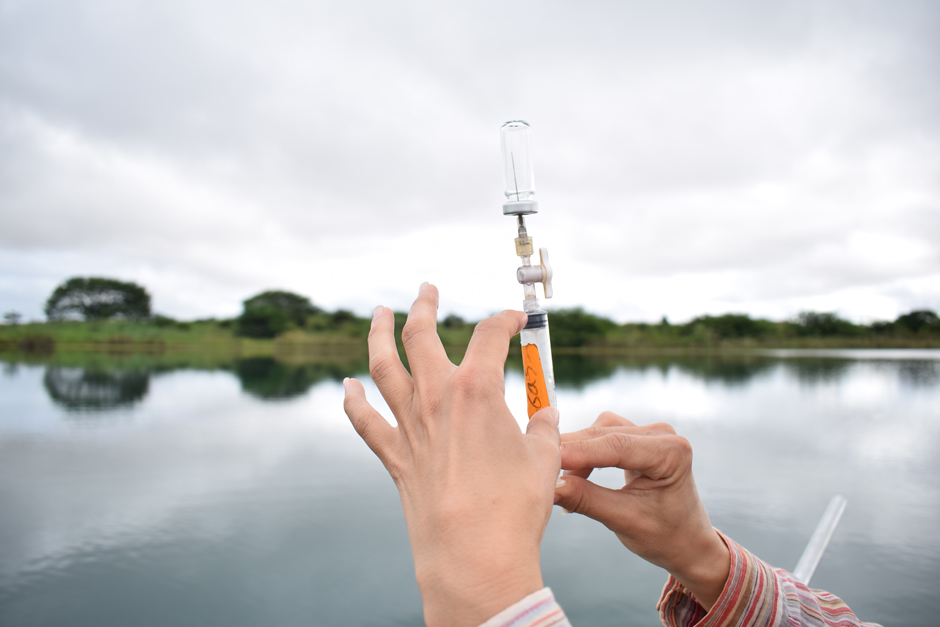
Marcia Macedo, a scientist at the Woodwell Climate Research Center, transfers a gas sample collected from a reservoir to a preevacuated vial for later laboratory analysis. She has collected thousands of samples from dozens of reservoirs in the southeastern Amazon to help understand the impact of these water bodies on greenhouse gas (methane and carbon dioxide) emissions from the region. (Credit: Karinna Matozinhos / IPAM).
These water bodies represent a big change compared to undisturbed headwater streams, which are typically shaded by overhanging riparian forests and fed by groundwater that keeps stream temperatures at a steady 24oC. Once deforested or dammed, the hot tropical sun can reach streams and reservoirs, causing dramatic changes in water temperature. Macedo’s team showed that one small reservoir can increase water temperature by 5oC from the inlet to the outlet. Once re-entering the stream, it takes over a kilometer for that temperature to recover to its natural background level. In many cases, additional downstream reservoirs keep the temperature from recovering at all.
“Here’s a practice that makes sense at one scale, but not when you add it up. We mapped 10,000 of these in the upper Xingu River Basin, which covers 186,000 square kilometers. That’s roughly one for every 7km of stream length,” says Macedo. “What does that mean for fish? Unlike humans, fish can’t regulate their body temperature relative to their environment. If they evolved in stream environments with constant 24oC water temperature and suddenly they’re experiencing high variability and 31oC water, that will directly affect their metabolism – and with it their ability to grow and thrive in the new environment.”
The reservoirs only worsen the harm caused by riparian forest degradation and deforestation, as streams and rivers have less tree cover to shade them from sunlight and contribute food and nutrients to the aquatic ecosystem below. They may also create hotspots of methane, a powerful greenhouse gas produced by bacteria living in the low-oxygen sediments along reservoir bottoms. Macedo’s ongoing research is focused on measuring methane emissions from these small reservoirs – a critical step for understanding how they impact carbon cycling, ensuring these often-overlooked greenhouse gas emissions are accounted for, and devising strategies to minimize those emissions.
The Importance of Sustainable Development
The principles of sustainable development often seem at odds with present-day notions of productivity. “It’s counterintuitive at times – kind of the reverse logic of economics. In the context of agricultural production, we may actually need to discount present-day production and profits to ensure a resilient system that can sustain production over the long term. It’s a hard problem to solve,” states Macedo. Even so, many governments across the globe have tried to strike a balance by recommending practices that mitigate damages and incentivize sustainable practices.
Producing commodity crops on tropical soils requires a great deal of inputs, including additions of lime to correct soil acidity and nutrients such as nitrogen and phosphorus to increase soil fertility. Where Macedo works, these inputs are applied with great precision such that crops get exactly what they need and runoff is minimized. Nevertheless, these practices may not be sustainable over the long term; phosphorous, for example, is a finite resource that will run out eventually.
Likewise, growing vast expanses of crop monocultures requires many herbicides and pesticides to outcompete ever-evolving diseases and crop pests. “Soon, we’ll have to have a global conversation about our food systems and what to do over the long term. I don’t think this mode of production can be sustained for very long, particularly in the face of a rapidly changing climate,” Macedo states.
As for right now, the best option is to protect and sustain what one can. Macedo explains, “Sustainability can include small actions to minimize negative impacts now, but it also connects to ethics and broader social systems. We have a moral obligation to minimize impacts on Indigenous people downstream, for example, and to ensure fair, healthy, and equitable workplaces for the people working on these farms, not to mention considering the rights of future generations.”
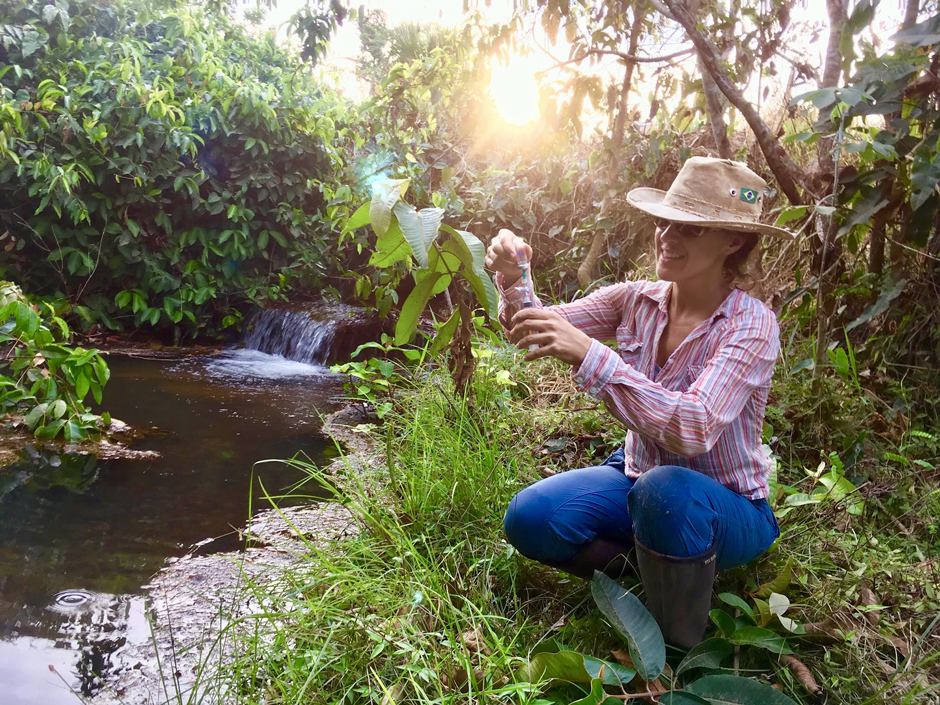
Dr. Marcia Macedo collecting a sample to measure greenhouse gases (methane and carbon dioxide) dissolved in water downstream of a reservoir in Mato Grosso, Brazil. Samples are collected in the field for later laboratory analysis at Woodwell Climate Research Center. (Credit: Paul Lefebvre)
Site-Specific Sustainability
Today, tropical land use changes occur largely to meet the global demand for plant and animal products. Macedo states, “I don’t blame farmers who are supplying a global market for soybeans for doing what they’re doing. I think revealing these underlying market connections – and understanding the unintended consequences associated with large-scale production – must be part of the solution.”
To ensure that the impacts of land use are considered from various perspectives, Macedo works with a large team of researchers, farmers, and representatives from the Amazon Environmental Research Institute (IPAM), a Brazilian non-profit organization working at the intersection of science and policy. After identifying the source of the problem and its impacts, this team works to translate the science and communicate how these practices may impact regional climate, local biodiversity, and global climate changes.
The solutions aren’t necessarily large, sweeping policy changes or restrictions. Sometimes they amount to practical alternatives that help optimize fertilizer applications, repair degradation caused by land use changes, and minimize impacts when possible. Having worked in the same region for so long, Macedo explains, “It’s been really gratifying to be in the same place for so long because there’s a relationship of trust between the farmers and researchers. We’ve been able to ask some questions together on how to accomplish what they need to do while also minimizing environmental impacts.”
Another important aspect of crafting sustainable development plans is moving away from “one-size-fits-all” solutions by working to understand regional differences – how each system works and what it needs. For example, much of the early scientific literature about the effects of deforestation and agricultural production came from temperate regions, where agricultural practices, rainfall, and soil characteristics often lead to surface runoff that carries nutrients and sediments into streams and lakes. Without careful management, these processes may lead to persistent water quality problems (e.g., eutrophication) that degrade freshwater systems. When they began studying tropical regions growing the same crops with similar approaches, Macedo and her colleagues expected to find similar processes at work, but their results surprised them.
Watersheds in the Amazon and Cerrado are quite different environments compared to the temperate zone. Soils are old and highly weathered, meaning they are deep – often 10 meters or more – and have a high infiltration capacity. Instead of running over land, rainwater carrying nutrients has time to percolate through the soil column. From there, the water and nutrients work their way throughout the watershed, so by the time they reach the stream, most nutrients have been trapped in the soil or taken up by plants, preventing the nutrient loading and high turbidity seen in many temperate case studies.
In this case, the “common knowledge” afforded by the literature did not apply to the tropical landscape where they worked. While they are still looking into other dimensions of environmental changes in these landscapes, these findings are a good reminder that management strategies must be tailored for different places and contexts. Macedo notes, “I think sustainability means different things in different landscapes and at different scales.”
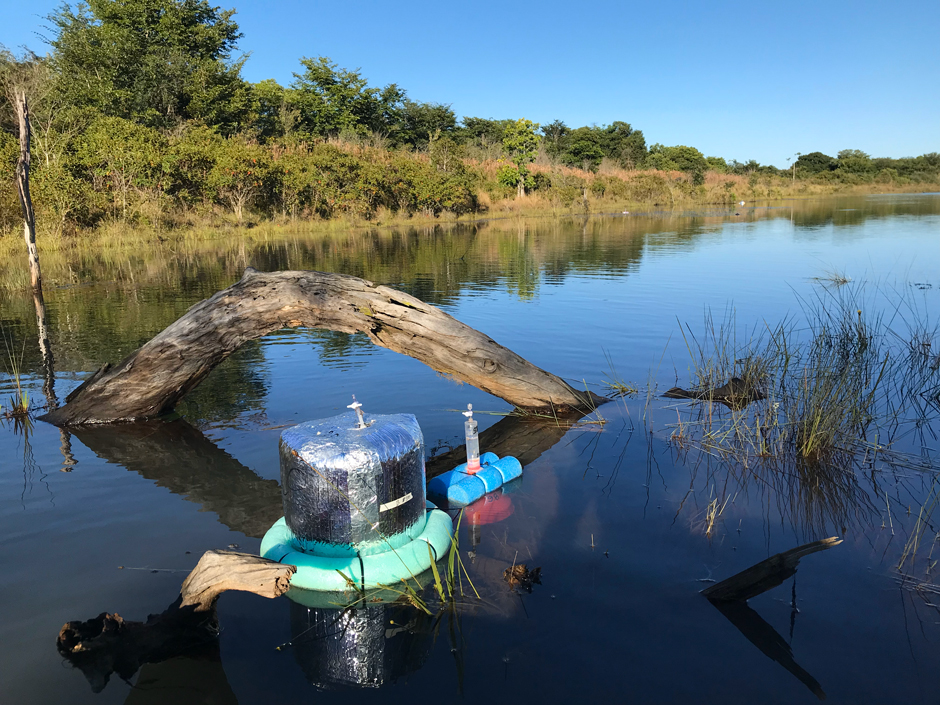
Submerged tree trunks in a small reservoir in Mato Grosso, Brazil. Building dams floods a large area upstream, killing most standing trees as a result. Mauritia palm trees are a notable exception: they are well-adapted to wetland areas and can be found scattered throughout some reservoirs in the region. (Credit: Marcia Macedo)
Studying Systems to Improve Sustainable Development
Understanding these different scales requires an in-depth understanding of the systems involved, including forests and water systems. Macedo’s team relies on several Fondriest Environmental products to closely examine how the removal of forests impacts water systems in these landscapes. For example, the health of riparian forests along the stream, fish communities, and water quality can all be affected by changes to the systems they rely on.
With all the ways her work overlaps with other systems, Macedo’s field work looks a bit different than other researchers. Macedo utilizes devices like a YSI EXO Sonde and other devices/systems to monitor water quality parameters like turbidity, discharge, water level, and temperature. They also examine system behaviors like water flows in and out of the forest or agriculture field, how much the forest exchanges carbon dioxide and oxygen, and how much water is recycled by evapotranspiration. This data provides a baseline for understanding how the system is faring overall and how forested watersheds compare with agricultural watersheds, which helps inform future decisions and practices.
When measuring streams and reservoirs is not possible with a sonde, the team has to get a bit more creative. Measuring methane emissions from reservoirs, for example, whether released via bubbles formed in the sediments or by diffusion at the reservoir surface, presents its own challenges. Still, the data is important for understanding their greenhouse gas contributions. To do this, the team pairs water quality measurements using a YSI meter with measurements from floating gas chambers and bubble traps constructed from readily available materials such as water jugs, pool noodles, funnels used for oil changes, and 60-mL syringes. These contraptions help Macedo and her team trap bubbles and diffuse gas emissions to measure how much methane and carbon dioxide are emitted.
Understanding the health and functioning of the forests that border streams and reservoirs is another significant part of Macedo’s work. Despite being near water, riparian forests are quite vulnerable to degradation. Where Macedo works, these forests are often small strips of land, surrounded by big soybean fields and exposed to stressors such as windthrow, fires, herbicides, and drying from the hotter landscape after deforestation. While they are protected by law, frequent disturbances and other edge effects may cause riparian forests to degrade over time.
Monitoring these forests to see how they’re doing over time and where restoration efforts should be directed is, thus, a large part of the equation. Fortunately, about 80 percent of riparian zone species persist despite evidence of degradation. The forests also serve essential functions in terms of being a corridor for wildlife, filtering pollutants coming off the landscape into streams, shading streams and keeping them cool, and dropping leaves and insects that form the base of stream food webs.
Protecting and preserving these environments also helps protect the people, cultures, and ecological functions of the Amazon. But for Macedo this work is also deeply personal. She explains, “I’m Brazilian – a first generation immigrant to the US – so I’ve always had a strong connection to this landscape and these issues. It’s really gratifying for me to be able to maintain that connection by going back to Brazil often to learn about these systems and, hopefully, to contribute to their conservation.”
Conclusion
Thanks to growing discussions surrounding the climate and responsible resource use, Macedo is hopeful for the future. She attributes a lot of that potential success to science-based policies, as well as ongoing changes in business practices and individual choices. Macedo explains, “I think the world is waking up to the reality of climate change for one, and also to the interconnectedness of these markets.”
Global negotiations have shined a light on many practices that were previously hidden. It’s increasingly hard to ignore the data and public desire for more sustainable options. Companies and individual consumers have started to listen to the science behind sustainable practices as they look toward the future. Macedo states, “There’s been a revolution in the data available to help us understand the world. Having that information at our fingertips makes it a lot easier to make more informed decisions and think more systemically about what we’re doing to the planet.”
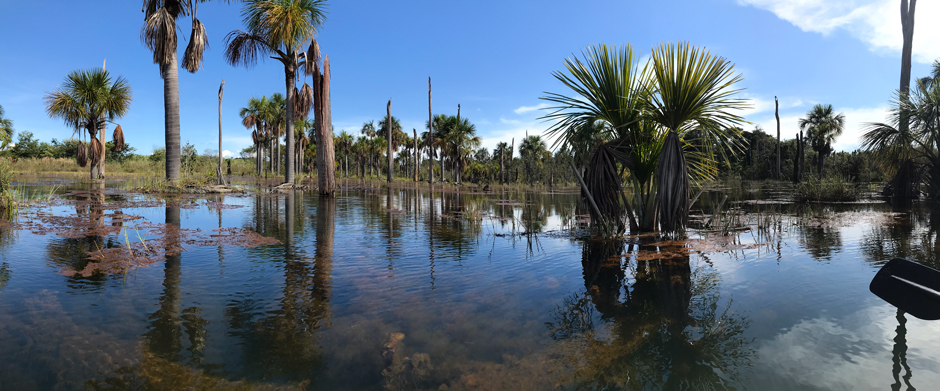
Submerged tree trunks in a small reservoir in Mato Grosso, Brazil. Building dams floods a large area upstream, killing most standing trees as a result. Mauritia palm trees are a notable exception: they are well-adapted to wetland areas and can be found scattered throughout some reservoirs in the region. (Credit: Marcia Macedo)




Pingback: The Art of Sustainable Development: Monitoring Riparian Zones in the Amazon – admin